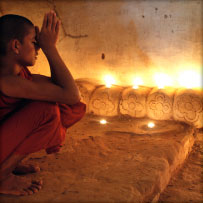Difference between revisions of "Paying homage"
(Created page with "thumb|250px| When a Buddhist approaches to pay homage to the Buddha and members of the Sanmgha, he must take a suitable place putting his palms t...") |
|||
| Line 1: | Line 1: | ||
[[File:06sd.jpg|thumb|250px|]] | [[File:06sd.jpg|thumb|250px|]] | ||
| − | |||
| − | |||
| − | |||
| − | + | When a [[Buddhist]] approaches to pay homage to the [[Buddha]] and members of the [[Sanmgha]], he must take a suitable place putting his palms together on his {{Wiki|forehead}} respectfully. | |
| − | + | The suitable place should be free from [[six faults]] of location: being too far; being too near, being at the front, being at the back, being at a high place and being against the [[wind]]. | |
| − | + | Then he should supplicate something what he wishes. | |
| − | + | After that, he should pay homage to them and go back from them taking four or five steps backward and with joined-palms on his {{Wiki|forehead}}, without turning his back to them. | |
| − | |||
| − | |||
| − | ==== | + | ==== [[Three modes of paying homage]] ==== |
| − | A male-devotee should sit in a squatting [[posture]] and a female-devotee should sit with limbs drawn together for paying homage by means of the fivefold manner of touch. | + | |
| + | |||
| + | (a) [[Paying homage]] {{Wiki|physically}} ([[kayavandana]]); | ||
| + | |||
| + | (b) [[Paying homage]] verbally ([[vacivandana]]): and | ||
| + | |||
| + | (c) [[Paying homage]] [[mentally]] ([[Manovandana]]). | ||
| + | |||
| + | |||
| + | |||
| + | ==== [[Paying homage physically]] ==== | ||
| + | |||
| + | |||
| + | |||
| + | One who pays homage {{Wiki|physically}} to the [[Buddha]] and the [[Samgha]] has to {{Wiki|touch}} the ground or the floor with five parts of one's [[body]]. These five parts of [[body]] are: {{Wiki|forehead}}, two hands and two knees. This is called the five fold manner of {{Wiki|touch}}. | ||
| + | |||
| + | |||
| + | |||
| + | ==== [[Paying homage while standing]] ==== | ||
| + | |||
| + | |||
| + | |||
| + | When a [[Buddhist]] meets the members of the [[Samgha]] on the way, he should stop his stepping, take off his head-wear and shoes. Then he should raise his joined-palms on his {{Wiki|forehead}} with his [[body]] leaning forwards. | ||
| + | |||
| + | |||
| + | |||
| + | ==== [[Paying homage while sitting]] ==== | ||
| + | |||
| + | |||
| + | |||
| + | A male-devotee should sit in a squatting [[posture]] and a female-devotee should sit with limbs drawn together for [[paying homage]] by means of the fivefold manner of {{Wiki|touch}}. | ||
{{R}} | {{R}} | ||
Latest revision as of 06:38, 26 February 2016
When a Buddhist approaches to pay homage to the Buddha and members of the Sanmgha, he must take a suitable place putting his palms together on his forehead respectfully.
The suitable place should be free from six faults of location: being too far; being too near, being at the front, being at the back, being at a high place and being against the wind.
Then he should supplicate something what he wishes.
After that, he should pay homage to them and go back from them taking four or five steps backward and with joined-palms on his forehead, without turning his back to them.
Three modes of paying homage
(a) Paying homage physically (kayavandana);
(b) Paying homage verbally (vacivandana): and
(c) Paying homage mentally (Manovandana).
Paying homage physically
One who pays homage physically to the Buddha and the Samgha has to touch the ground or the floor with five parts of one's body. These five parts of body are: forehead, two hands and two knees. This is called the five fold manner of touch.
Paying homage while standing
When a Buddhist meets the members of the Samgha on the way, he should stop his stepping, take off his head-wear and shoes. Then he should raise his joined-palms on his forehead with his body leaning forwards.
Paying homage while sitting
A male-devotee should sit in a squatting posture and a female-devotee should sit with limbs drawn together for paying homage by means of the fivefold manner of touch.
